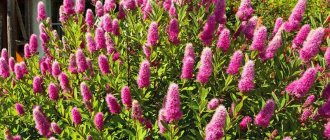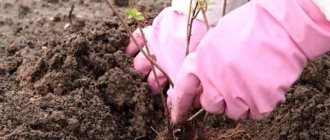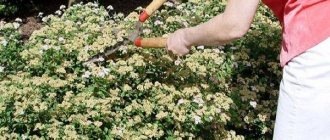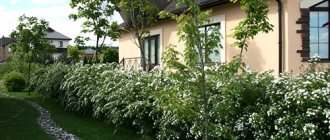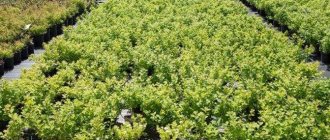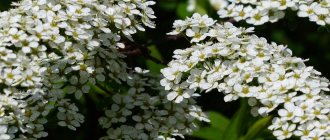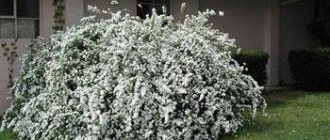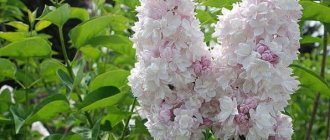I really like the ornamental shrubs of Japanese spirea Goldmound:
Which my father planted about 8 years ago. Now spirea is a memory of him. I really like the shrubs for their color scheme: the leaves are an amazing lemon-yellow color.
Bushes naturally have rounded shapes. Height up to 90 cm, diameter up to one meter. Annual growth is 10-15 cm. Easy to trim (shape). The flowers are large, bright pink. Blooms in June-July. Repeat flowering occurs in August-September. Well suited for small hedges and borders.
In my garden, spirea goes well with peonies and decorative poppies. Beautifully combined in colors:
This year I started propagating it on the site, I want to make some interesting landscape composition.
I advise everyone to purchase Japanese spirea Goldmound in their garden, you will not be disappointed.
Search
Cart (0)
Catalog
Last news
TV report – Yurko Farm
- 16.01.2019
Rozhdestveno became a partner of the Ideal Repair project
- 30.08.2018
Visiting the Rozhdestveno nursery
- 16.01.2019
Japanese spirea 'Goldmound' Spiraea japonica 'Goldmound'
- Description Additional information –>
Spiraea Goldmound is a low-growing ornamental shrub of the deciduous group. The plant is highly valued in landscape design for the fact that it retains its attractive appearance until the first frost, which allows you to add color to a faded autumn garden. This shrub is especially popular among gardeners due to the low price of planting material and the unpretentiousness of the variety.
Reproduction
The most effective way to propagate the Goldmound variety is by cuttings. Both green and woody cuttings are suitable for this.
The reproduction procedure in this case looks like this:
- In summer, a young non-flowering shoot is selected from the bush and cut at the base.
- This section is divided into several more parts of 15 cm, no more.
- The resulting cuttings are cleared of leaves at the bottom and buried in the ground. For this it is better to use a greenhouse.
- The plantings are covered with plastic film to create a greenhouse effect. It is important to make small holes in the shelter for air ventilation.
- As the cuttings develop, they are regularly sprayed with a spray bottle.
- In October, planting material is moved into open ground.
Advice! Spiraea takes root well without additional treatment, but if necessary, you can spray the planting material with a growth stimulator.
Young spirea can also be propagated by dividing the bush. Old bushes are not suitable for this.
The algorithm for dividing the bush is as follows:
- A young bush is dug out of the ground, focusing on the diameter of the crown. Damage to roots that are too long and extend beyond the specified area is allowed. When extracting the plant, try not to destroy the earthen lump.
- Then the spirea is lowered into a bucket or bowl of water for 1-2 hours. This is necessary so that the soil becomes softer - this will make it easier to clean the root system of the plant.
- The roots are watered with a hose, removing the soil from them, after which the spirea is taken out of the water and laid on its side.
- Using a sharp knife or garden shears, divide the common root system into 2-3 equal parts. Each division should have a sufficient number of buds and approximately the same volume of roots.
- The resulting parts are planted in pre-moistened holes and sprinkled with earth.
- The tree trunk area is lightly compacted and mulched.
Soon after planting, the division takes root.
Reproduction by seed occurs according to the following scheme:
- In spring, seeds are sown in wooden or plastic containers with pre-moistened soil. Recommended substrate composition: leaf soil and high-moor peat, mixed in a 1:1 ratio.
- The soil surface is mulched with peat for better moisture retention.
- After 8-10 days, the first shoots appear. They are immediately sprayed with Fundazol to protect against fungal infections.
- After 2-3 months, the seedlings are planted in separate containers.
- When spirea seedlings have formed a full-fledged root system, they can be planted in open ground.
- To do this, take them out of the containers and slightly shorten the roots.
- Then the seedlings are buried in dug up loose soil.
- Plantings are watered and mulched.
After 1 year, the height of the seedling should reach 10-15 cm. In subsequent years, the rate of development of the shrub increases.
Important! It is not recommended to grow hybrid varieties of spirea from seeds, since in this case there is a high probability that the seedlings will lose most of their varietal qualities.
Reproduction methods
Cuttings
According to experienced gardeners, “Goldmound” is recommended to be propagated by cuttings. You can use both woody and green cuttings.
The work is carried out as follows:
- in the warm season, non-flowering shoots are cut at the base of the bush;
- the cut young shoot is cut into several parts, 15 centimeters each;
- After stripping the lower leaves, the resulting cuttings are deepened into the ground;
- It is better to germinate the plant in a greenhouse;
- to create a greenhouse effect, cover the planting site with thick polyethylene, do not forget to make several holes for air circulation;
- periodically moisten the soil as the cuttings take root;
- by the second autumn month, the finished planting material is transplanted into open areas;
- in favorable conditions, cuttings take root without special compounds, but if necessary, they can be treated with a preparation to stimulate growth.
Division
Young shrubs can be propagated by dividing the bush. This method is not suitable for adult plants.
The procedure is carried out according to the following scheme:
- the young plant is carefully removed from the ground, the earthen lump is not destroyed, minor damage to overly long roots is allowed;
- the shrub is dipped in a container of water and left for 1–2 hours, the liquid will soften the earth lump, and it will be much more convenient to remove it;
- the remaining soil is removed by watering the root system with a hose;
- using a sharp knife or scissors, the root system is divided into several different parts (2–3), each formed shrub should have the same number of roots and buds;
- plants are planted in holes with pre-moistened soil and carefully sprinkled with soil;
- The planting area is covered with a layer of mulch.
Seeds
To grow a plant from seeds, you need to be patient.
To obtain seedlings, you should perform the following steps:
- with the arrival of spring, the seed is sown in containers with moist soil; it is recommended to use the following composition as a soil mixture: high-moor peat and leaf soil in equal proportions;
- the top layer of soil is mulched to maintain optimal moisture levels;
- after 8–10 days, shoots will appear, it is recommended to treat them with “Fundazol”;
- after a few months (2–3), the young plants are transplanted into separate containers;
- after the formation of the root system, the plants can be transplanted into open ground;
- seedlings are planted in carefully dug soil;
- The area is watered and mulched.
After a year, the seedlings will grow to a maximum of 15 centimeters. Next season their growth rate will increase.
The note
Experts say that it is not worth choosing this method of reproduction for hybrid varieties. The fact is that seed material can lose many varietal qualities of the plant.
Spiraea viburnum (Physocarpus opulifolius)
Found in the middle zone not only of the European part of Russia, but also in North America, as well as in Siberia, the viburnum vesicle is often known to gardeners as spirea viburnum. Indeed, the plants belong to the same family and are somewhat similar in appearance, but it is incorrect to call this plant spirea.
The spherical crown of the bush, up to 3 meters high, is formed from drooping branches. The leaves are three-lobed, corrugated with heavily dissected edges; their shape is very reminiscent of viburnum leaves, which gave the name to this species. The color of the foliage can be either dark green, bronze or burgundy. From mid-June to the end of July, the crown of the vesicular carp is covered with round corymbose inflorescences, consisting of many small white or pinkish flowers.
Spiraea rowan leaf (Sorbaria sorbifolia)
Another ornamental plant that claims to be called rowan-leaved spirea is fieldfare, an indigenous inhabitant of Siberia and the Far East, cultivated today from the northern border of the forest zone of Russia to the steppes. Confusion in the classification is caused by the external similarity of fieldfare and some species of spirea, as well as their common membership in the Rosaceae family. However, fieldfare belongs to a different genus than spirea, but this does not make it a less attractive and interesting plant, reaching a height of 3 meters in 4 years.
A large shrub that lives up to 20 years has erect branches with brownish-gray bark, forming a dense spherical crown. The leaves are really similar to the foliage of rowan, but more pointed. And young foliage, which is one of the first to appear in the garden, is often purple in color. In July, white fragrant flowers collected in pyramidal paniculate inflorescences, up to 20–25 cm long, open abundantly.
Video about Spirea Gold Mound
Landing
Spiraea goldflame loves the sun, therefore, when choosing a place to plant a shrub, you should give preference to an open area that will receive a lot of light. Without the sun, the spirea leaves will turn green, lose their decorative properties, and the plant will bloom sparingly.
The plant itself is unpretentious, but if you take into account all the few needs for the best flowering of the shrub, it will give maximum growth and beauty. The soil for planting should be chosen fertile, with moderate humidity, and there should be good drainage. If you plant spirea on acidic soil, this will affect the color of the foliage - it will be brighter, the color will reach purple.
Also note that spirea will produce basal shoots, so it will take up more space, therefore, it is worth taking into account the area and allocating more space for the shrub.
Since spirea is an undemanding plant, planting and growing it will not be difficult. When purchasing seedlings, pay attention to the roots - they must be moist. If they are dry, it means the plant is unhealthy and will not take root. Also look at the shoots - a healthy plant has mobile shoots with pronounced buds.
The hole for planting should be dug in advance, about two to four days before planting. The planting itself should be carried out not in sunny weather, but in cloudy or even rainy weather. Its size should be taken into account relative to the volume and diameter of the roots; the hole should be one and a half times the size of the roots.
Materials that can be purchased at a gardening store, as well as broken bricks, are suitable for drainage. The drainage layer is approximately twenty centimeters. The soil mixture should consist of a 3:2:1:1 ratio of turf soil, humus, peat and sand, respectively.
Carefully place the seedling in a hole prepared in advance, straighten the roots and sprinkle with soil mixture up to the root collar. When planting is complete, the seedling needs to be watered generously and small holes made in the soil to retain moisture.
Rules for disembarkation and departure
This variety is perfect for growing for beginners due to its simple agricultural technology and ease of care. In order for the shrub to feel great and delight with its charming appearance, it is enough to follow simple rules.
The plant can fully develop in almost any soil, but experts recommend growing it in drained and moist soil. Sandy and loamy soils with low acidity are also ideal for spirea.
"Goldmound" loves warmth and moderate sunlight. If possible, choose illuminated locations for gardening. Lack of sunlight changes the color of the foliage from bright golden to light green.
Preparing seedlings and site
If you use ready-made seedlings to grow a plant, carefully evaluate their condition and get rid of unsuitable ones. Healthy and strong seedlings are characterized by green bark, moist roots and flexibility in the stem. There should be no black spots or other marks on the sections.
Before planting in open ground, seedlings should be disinfected. This way you protect the plant from possible diseases and minimize the risk of fungus. The treatment is carried out using a weak solution of manganese.
If the root system is too long, it should be shortened using garden shears. The selected area should be carefully dug up several weeks before transplantation and fertilized.
Planting shrubs
It is recommended to plant the plant at the end of the first spring month.
The work is carried out as follows:
- the optimal pit depth should be from 40 to 50 centimeters;
- it is necessary to focus on the size of the roots; a hole is dug with a reserve of free space of 20%;
- at the bottom of the planting pit, make a drainage layer of gravel or pieces of brick;
- the drainage is covered with a soil mixture; to prepare it, sand, peat and turf soil are mixed, the soil is formed into a small hill;
- the seedlings are placed on a hill, and the roots are distributed along the slopes;
- the root system must be carefully sprinkled with earth and the soil lightly compacted;
- At the end of the work, you should water the plant.
Watering and fertilizing
This representative of the flora has average drought resistance. Shrubs need to be watered periodically, otherwise this will negatively affect their growth.
Many experienced gardeners recommend using fertilizers if spirea grows in poor soil. If the seedlings are planted in fertile soil, the spirea will delight you with a thick crown even without additional fertilizing.
Organic compounds that are applied once a year - in the spring - are excellent as fertilizers.
Mulch is also used to nourish the root system.
Shrub pruning
Regular pruning is recommended to maintain an attractive appearance. The procedure is carried out approximately once a month. It is worth noting that this excludes subsequent flowering of the plant. When choosing a spirea for your garden, you should decide on the purpose of the plant and, depending on this, prune it or not.
Sanitary pruning is performed in order to preserve and maintain the shape of the crown. Weak, dry and damaged shoots should also be removed. Adult shrubs aged 4–5 years are treated more intensively than young plants. During work, 3–5 branches are removed to the base.
Description of Spirea Goldmound
Spiraea japonica Goldmound is represented by a low cushion-shaped bush, as seen in the photo below. The height of the bush is on average 50-60 cm, diameter is about 80 cm. Spiraea leaves are elongated, narrowed at one end and jagged along the edge. They are shaped like an egg. The crown of the bush is dense. The color of the leaf blade of this variety varies depending on time and growing conditions:
- young, newly blossomed leaves have a pinkish-red color;
- in summer, spirea changes its color to golden yellow when grown in open, well-lit areas;
- during the same period, the plant can be painted in delicate light green tones if it is grown in the shade;
- By autumn, the color of the leaves smoothly turns into an orange-red hue.
The flowering of the variety begins in June and ends by the end of July. The flowers of Spiraea japonica Goldmound are small and pale pink. They form dense inflorescences in the form of scutes on the shoots of the current year. In October, small fruits form in place of these flowers.
Reproduction of spirea
Spiraea can be propagated by seeds, cuttings and layering. Seeds that have ripened from hybrids (spirea Van Gutta, Billard, Boumalda, gray, Arguta and all varieties) are not used, since the seedlings from them will be heterogeneous. Seeds are sown in early spring in boxes with an earthen mixture and 2-3 months after the emergence of seedlings, they are planted on the garden bed, having previously pinched the end of the main root to develop a more powerful root system. Seedlings bloom 3-4 years after planting, all this time they need careful care - weeding, loosening the soil and frequent watering.
In order to fully preserve all the characteristics of the variety, spirea must be propagated vegetatively - by cuttings or layering. Cuttings are cut from semi-lignified shoots of the current year, 10 cm long, both apical and from the middle part. To improve root formation, you can use “Kornevin” by dipping the ends of the cuttings into the solution immediately before planting. If you plant cuttings in July, then by autumn good roots will have formed.
If the number of new plants required is small, then you can use a reliable and hassle-free method - propagation by layering. To do this in the spring, when the leaves are blooming, you need to bend the branches growing along the periphery of the bush to the ground, pin them with wire and sprinkle them with earth. You can also tie them to pegs, giving the branches a vertical position. If you keep the soil around the bush in a moderately moist state throughout the entire season, then by autumn or next spring you can get independent plants. And if you remove the very first inflorescences on young bushes, their development will proceed much faster.
Care
As mentioned above, Japanese spirea is an unpretentious shrub, so caring for it will not be difficult. Young spirea, in the first year, requires abundant watering. Also, a young plant should be protected from the cold, since in the first year it may die from severe frost.
Watering
Over time, a mature plant can survive short periods of drought and cold. During hot periods, it is worth pouring two buckets of water on the spirea once every two weeks. In moderate weather conditions, spirea should be watered sparingly, after each watering, loosen the soil and pull out emerging weeds in a timely manner.
Mulching
To retain water longer after watering, you can mulch the soil with peat. During frosts, to prevent the plant from dying, it is worth loosening and mulching the soil and placing dry leaves under the branches. Fasten the spirea branches together and bend them to the ground, then cover the fixed branches of the bush with insulation.
Top dressing
Fertilize spirea every year. It is best to fertilize three or four times a season. To preserve the beauty and health of shrubs after fertilizing, they should be watered abundantly. Among the fertilizers, Kemira-universal is very common - it is used by both amateur gardeners and professional landscapers. It is highly effective, and superphosphate can also be added to it.
Trimming
Spiraea goldflame is pruned in the spring on plants that have already reached four years of age. Since this shrub grows at a normal rate, pruning once a year will do a good job of stimulating further plant development.
Typically, weak, dried out, broken branches that were damaged during winter are removed. A small area is trimmed down to the first large buds. You can trim more, entirely frostbitten or damaged branches, since spirea responds well to pruning.
It is often pruned right down to the stump, this stimulates the growth of young, fresh branches. Such bold pruning is carried out precisely to rejuvenate the plant and lengthen its life. The more the bush is pruned, the more luxuriant and healthy the new branches will grow.
Spiraea japonica Macrophylla
Belonging to the group of summer-flowering shrubs, Spiraea Macrophila is valuable not for its pink inflorescences, but for its variegated foliage, the color of which becomes more saturated at the tops of the shoots and creates the main decorative effect. The wrinkled, dissected leaves of this species, which are unusually large for a spirea, reach 20 cm in length and 10 cm in width. In spring they have a violet or purple-red color, in which by the height of summer green tones already predominate, and by autumn the foliage becomes golden yellow.
Thanks to the high growth rate inherent in Spiraea Macrophila , and pruning the plant in May to a height of 10–30 cm from the ground level, gardeners achieve a constantly bright color of the apical leaves on newly emerging shoots, as in the photo of the spirea. The plant tolerates moderate frosts without loss and does not require additional shelter for the winter. When decorating a garden, spirea of this type is indispensable in flower beds composed of perennial flowering plants, as a frame for garden paths and as decoration for the sunny side of buildings.
Use in landscape design
The diversity of species allows the use of spirea in landscapes of different directions: Japanese, English, rural, pastoral, French, Russian. Low-growing species are used to create borders along garden paths and colorful curtains in green meadows.
Their root system perfectly tolerates cramped growth conditions, so plants of small habit are used in mobile landscaping of terraces, paved courtyards, patios, and pool areas.
Landscape designers use tall spirea as solitary plants, planting the bushes at a fairly large distance from one another. In this design, they look great on mowed lawns, without requiring additional decorative planting.
Free-growing hedges are picturesque, most often made up of one, less often several types of spirea.
Spiraea japonica Crispa
The graceful spirea Crispa is a shrub with a spherical crown formed from erect or slightly drooping shoots. The height of the unpretentious plant, suitable for use in borders or growing in containers, is about 0.6 meters. Numerous shoots are covered with oblong leaves, heavily dissected along the edges, which are reddish in color when they appear, become predominantly green in the summer, and by October they acquire an orange, bronze or purple color.
The flowers of this variety, like the spirea in the photo, are simple, pink or purple and are collected in small inflorescences up to 6 cm in diameter. Any soil is suitable for Crispa spirea, as long as it is well aerated and not oversaturated with moisture. If in particularly frosty winters some of the shoots suffer. After pruning, the bush is easily restored, but it is important to consider that the growth rate of this variety is low.
Spiraea salicifolia Rosea
Pink spirea or Rosea is an unpretentious shrub that blooms profusely from mid-summer until autumn. An adult plant reaches a height of one and a half meters and forms a vertically directed rounded crown up to 1.3–1.5 meters in diameter. A characteristic feature of the variety is high winter hardiness and a 20-centimeter annual growth of powerful, erect shoots covered with red-brown bark. Pink spirea has elongated, up to 10 cm long green leaves and small pink flowers collected in dense paniculate inflorescences.
Read also: Altai sea buckthorn: description of the variety, photos, reviews
Description of the plant
The main feature of the species is its compact size: the height of the plant is from 50 to 60 centimeters with a diameter of approximately 80 centimeters.
Experts describe the shape of the bush as cushion-shaped. The leaves are lush, elongated and decorated with teeth on one edge.
Due to the dense crown, the plant has a charming appearance.
Another decorative feature of the species is the color of the foliage, which varies depending on the time of year and climate in the growing region:
- young leaves enchant with their pleasant pink color with a scarlet tint;
- in summer, the shrubs change color to golden yellow, provided that they grow outdoors in a well-lit area;
- also in the hot season, the color of the leaves may be light green if the plant is in the shade;
- With the onset of autumn, the plant acquires an orange-red color.
young leaves summer autumn
The flowering period lasts from the beginning of summer until the end of July. At this time, the plant is covered with spherical inflorescences of a soft pink color. In the second autumn month, the flowers change to small fruits.
Agrotechnical features of growing Japanese spirea
By adhering to certain rules for the construction of spirea, you can grow flowering shrubs of unique beauty, which, moreover, are not particularly demanding.
Basic landing rules
The best time for planting is spring before the leaves begin to bloom.
Also, excellent adaptability and active rooting allow planting material planted in autumn to grow stronger before frost. And next summer you can decorate your garden plot with luxurious blooms.
Preparation of seedlings
It is better to buy planting material in specialized stores . The branches of the seedling should be flexible and have green bark and healthy buds.
Spiraea seedling
The root system is moist, elastic, without roots broken off or blackened when cut.
Determining the correct location
The main nuance when planting is the choice of site, in which you need to take into account such main criteria as:
good sunlight exposure ;
protection from cold northern winds;
the terrain of the site should be characterized by flat terrain , since the presence of lowlands can flood the crop, thereby provoking weak growth and development, which will ultimately lead to the death of the seedling;
fertile turf or leaf soil.
When planning a site, it is necessary to take into account that the roots grow strongly . Therefore, the distance between planting units should be at least 50cm.
Planting spirea in the garden
Stages of the planting process
- Make holes so that the root system fits freely in the planting hole without bending or creasing the roots.
- Place a drainage layer about 20cm thick on the bottom of the hole.
- Lower the seedling into the hole, carefully straightening the roots and cover it with soil substrate prepared from turf soil, peat, humus and sand.
- Compact the soil well and water thoroughly.
- When the moisture is absorbed, mulch with peat.
- After planting, dig holes near the trunks that will retain atmospheric moisture and water after watering.
Planting and caring for Japanese spirea Goldmound
Planting spirea of the Goldmound variety and subsequent care of the plant is not particularly difficult. This garden crop is undemanding to the composition and quality of the soil, although it prefers well-drained, moderately moist soils. The variety grows best on loamy and sandy loam soil of low acidity, but also develops well on other types.
Spiraea Goldmound is thermophilic, so when choosing a place to plant shrubs, you should focus on well-lit areas. With a lack of light, the bush changes its color from rich golden to light green.
Preparation of planting material and site
Spiraea seedlings must be carefully inspected before planting and unsuitable ones should be discarded. Healthy plants bend easily, have a greenish tint to the bark and moist roots without black spots on the cuts.
Immediately before planting, planting material must be disinfected - this will help reduce the risk of the bush becoming infected with fungus to a minimum. For disinfection, use a weak solution of potassium permanganate.
Important! It is recommended to trim too long roots using garden shears. This will simplify the process of deepening the spirea into the hole.
The area chosen for planting spirea is dug up 1-2 weeks before and organic fertilizers are added to the soil.
Rules for planting spirea Goldmound
Spirea of the Goldmound variety is planted in open ground at the end of March. The procedure is very simple:
- In a previously prepared area, dig a hole about 40-50 cm deep. In this case, you should focus on the size of the root system of the bush - the hole is dug with a margin of about 20%.
- Drainage in the form of broken bricks or gravel is placed at the bottom of the planting hole.
- A soil mixture of peat, sand and turf soil is placed on top of the drainage, and a small hill is formed from it.
- A seedling is placed on this hill and the roots of the spirea are spread along its slopes.
- Then the root system is sprinkled with the top layer of soil from the site.
- Planting is completed with moderate watering.
Watering and fertilizing
The drought resistance of the variety is average, so spirea bushes must be watered regularly. Otherwise, drying out soil will inhibit the growth of shrubs.
Spiraea is fed mainly on poor soils. When planted in fertile soil, the variety develops well without additional cultivation of the site.
Special mulching compounds or organic fertilizers are used as fertilizers. They are introduced into the soil once a year - in the spring.
Trimming
It is recommended to prune Goldmound spirea once every 30-40 days, however, this procedure automatically excludes subsequent flowering of the bush. That is why before planting a shrub, it is necessary to determine its role. Abundantly flowering forms are not pruned, unlike decorative deciduous ones.
Sanitary pruning is carried out in order to preserve the shape of the bush. To do this, only dry and broken branches are removed. Healthy shoots are not touched.
Important! Spireas that are 4-5 years old are pruned more intensively. They remove 3-5 branches to the very base.
You can learn more about the features of pruning spirea from the video below:
Preparing for winter
All varieties of spirea are considered quite cold-resistant plants. Nevertheless, it is recommended to cover young seedlings for the winter, since they are still weak and are not able to safely overwinter without protection.
Dry leaves or sawdust are used as shelter, which are sprinkled on shoots bent to the ground in a layer of up to 15 cm.
Diseases and pests
Spiraea is little susceptible to disease and almost does not attract pests. The only exceptions are weak, depleted plants that are unable to resist fungal infections and insect infestations.
Insect pests that attack spirea:
- Aphid. To combat aphids, spraying with Actellik or Fozalon is carried out. Among folk remedies, treatments with garlic tincture are effective;
- Whitefly. To combat the pest, Denis Profi is used, as well as a solution of laundry soap;
- Rose leaf roller. Destroyed by Fitoverm and copper sulfate;
- Spider mite. Causes the most significant damage; its presence is determined by a white coating on all parts of the plant. For destruction, the chemicals Metaphos, Phosfamide, Keltan and Fozapon are used.
- Meadowsweet sawfly. Denis Profi and Fitoverm are used for fighting.
Pests are detected visually during inspection of the bush. Neutralization measures are carried out as early as possible so that insects do not have time to cause significant harm to the plant.
When infected with fungal infections, Fitosporin and Fundazol are used, as well as Bordeaux mixture. Spraying with antifungal drugs is carried out 2-3 times per season with an interval of 7-10 days . If the treatments are not effective, it is recommended to get rid of the diseased plant by removing it completely from the area. This radical precaution will help protect healthy plants from infection.
